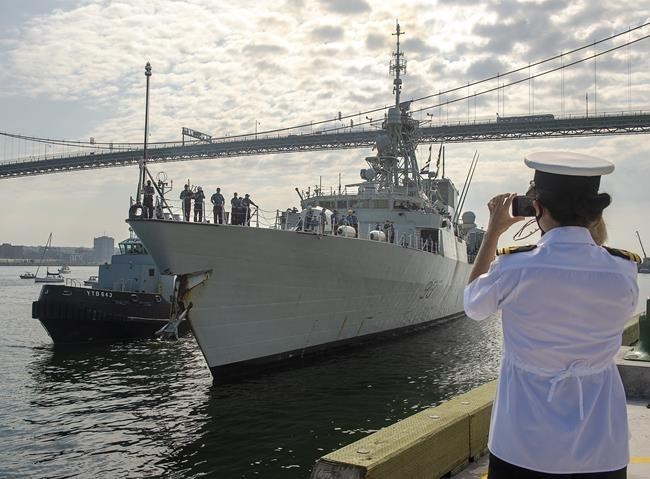OTTAWA — The commander of the Royal Canadian Navy says while the fire that broke out on HMCS Fredericton last month was not due to a systemic issue in Canada’s frigate fleet, the 30-year-old warships are starting to show their age.
Fredericton was leading a NATO taskforce off the coast of Norway when the fire erupted in the frigate’s forward engine room on Nov. 18. While no one was hurt, it took the crew more than 20 minutes to put out as they dealt with tight quarters and rough seas.
In an interview with The Canadian Press, Vice-Admiral Craig Baines said investigators believe the fire started after Fredericton's main pump broke and the crew set up a temporary bilge pump until it could be repaired.
“There was a temporary bilge pump installed with a non-fire-rated hose going up through the funnel intakes, and we believe that is what started the fire,” he said. “Once they fixed the regular pump, they just hadn't gotten around to removing the temporary one yet.”
While no injuries were reported, officials have said the 22-minute fight to put the blaze out was challenging due to the frigate’s cramped spaces and because it was operating in rough seas at the time.
The extent of the damage remains unclear, though the Defence Department says cabling and some control systems were melted or otherwise hurt by the heat. The warship was able to return to its home port in Halifax on Dec. 18, five days earlier than planned.
“Good news was it wasn't a systemic problem or anything,” Baines said. “Bad news is that it probably could have been avoided.”
Yet the fire on board Fredericton is nonetheless only the latest incident on Canada’s 12 frigates, which entered service in the early to mid-1990s and act as the navy’s workhorses. Those incidents include 10 other fires since 2018, as well as at least one power outage.
The Canadian Press also reported on an internal Defence Department review last year that found the navy’s maintenance facilities are having an increasingly tough time fixing Canada's warships because of staff shortages, lack of spare parts and the age of the fleet.
“There’s no question that we’re seeing the age of the ship,” Baines said. “There’s no denying that the ships are aging and, as a result, there’s going to be issues that will present themselves that we wouldn’t have seen earlier.”
The federal government has been working on getting replacements built as part of its multibillion-dollar national shipbuilding procurement plan, with 15 new warships due to be built by Irving Shipbuilding in Halifax at a cost of at least $56 billion.
The first of those new vessels, which will replace not only the navy’s 12 Halifax-class frigates but also the three Iroquois-class destroyers that have already been retired for nearly a decade, isn’t slated for delivery until at least the early 2030s.
The original plan was to have what are known in military circles as the “Canadian surface combatants” start entering service in the mid-2020s. But officials announced earlier this year that won’t happen, and there are concerns the pandemic could lead to more delays.
That will mean putting more money into Fredericton and the rest of the navy’s current frigate fleet to make sure Canada has enough warships to protect the country and operate overseas until the new vessels are in the water.
Baines could not provide an estimate of how much money could be needed to keep the Halifax-class frigates running, but said he is working with other parts of government to make sure the fleet gets the needed upgrades and repairs.
“They will need investment to keep them in the right state of readiness,” he said, adding: “We’re going to be very clear-eyed about what’s required to keep them going, and then what investment would be needed to keep the ships available and ready.”
This report by The Canadian Press was first published Dec. 29, 2021.
Lee Berthiaume, The Canadian Press



